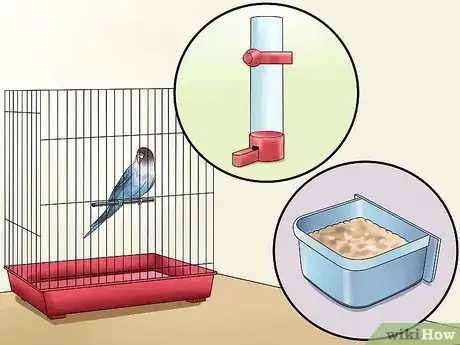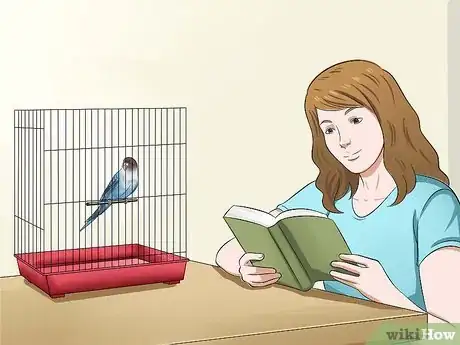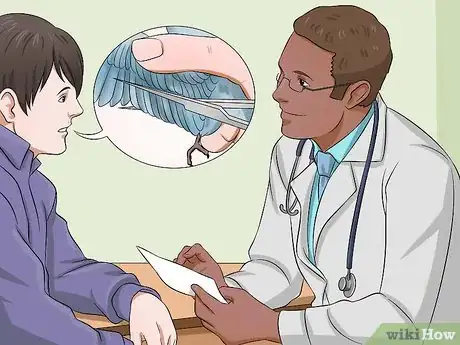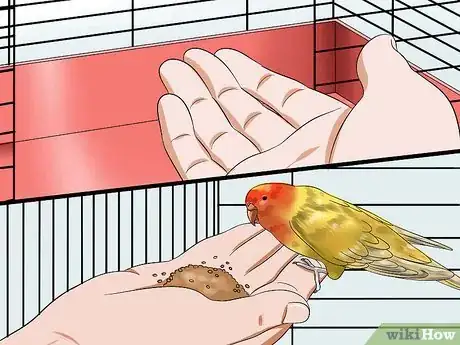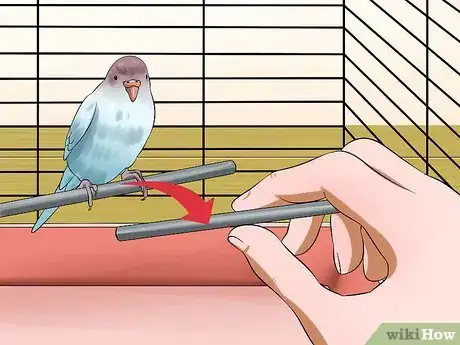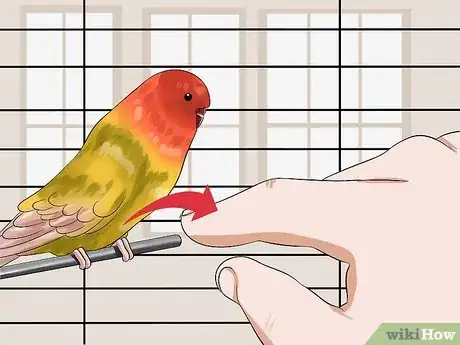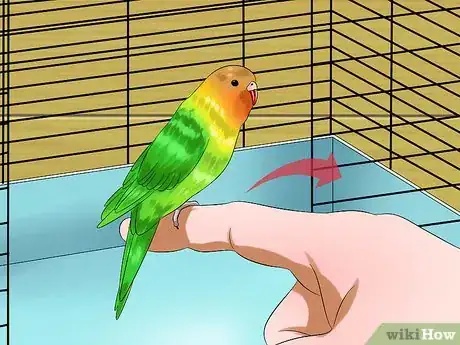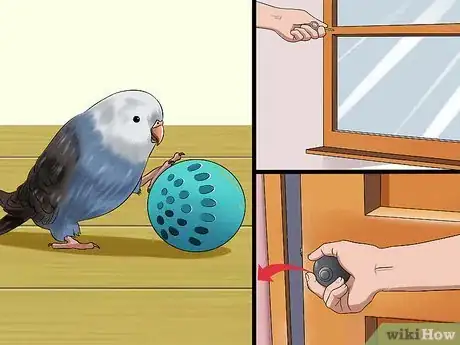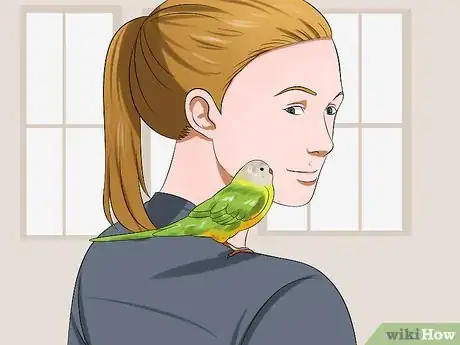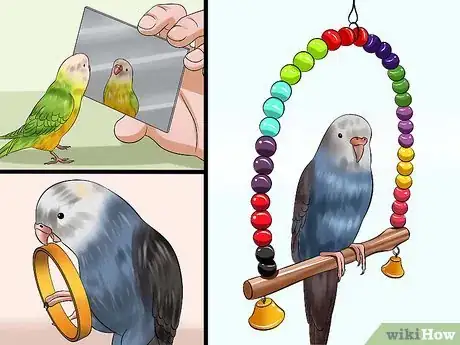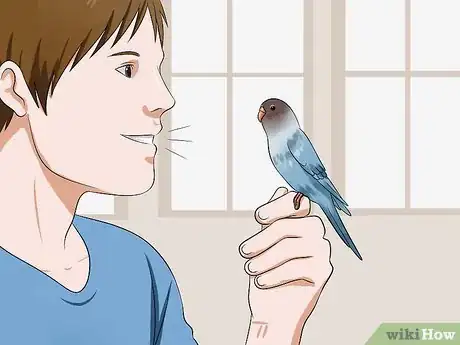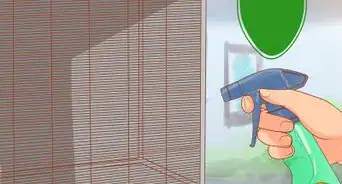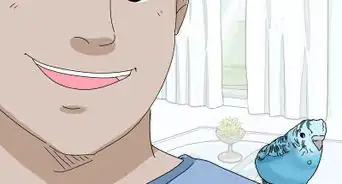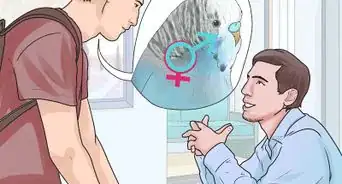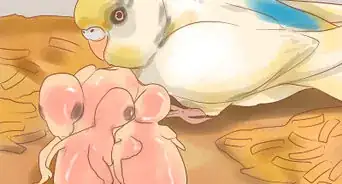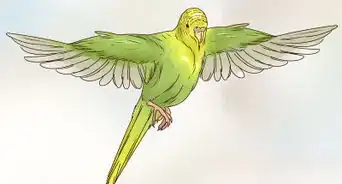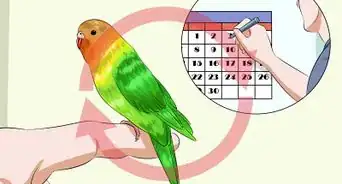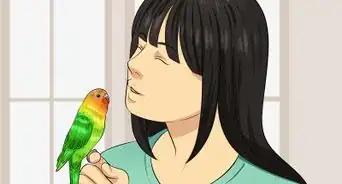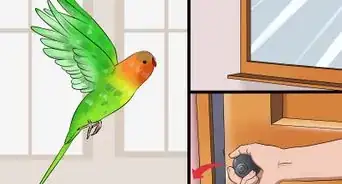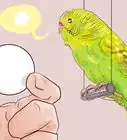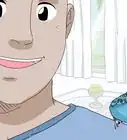This article was co-authored by Pippa Elliott, MRCVS. Dr. Elliott, BVMS, MRCVS is a veterinarian with over 30 years of experience in veterinary surgery and companion animal practice. She graduated from the University of Glasgow in 1987 with a degree in veterinary medicine and surgery. She has worked at the same animal clinic in her hometown for over 20 years.
wikiHow marks an article as reader-approved once it receives enough positive feedback. This article received 14 testimonials and 85% of readers who voted found it helpful, earning it our reader-approved status.
This article has been viewed 260,851 times.
Parakeets, also known as budgerigars or simply “budgies,” are a type of parrot native to Australia. Budgies are common pets around the world, and can be taught to do things like play with toys, sit on shoulders, and even mimic human speech. First, however, you need to build your budgie’s trust in you. Bonding with your budgie will take time and patience, but can also be lots of fun.
Steps
Getting Your Budgie Used to Its Surroundings
-
1Keep your budgie comfortable. Make sure that your budgie has an appropriate cage and easy access to food and water. All the necessary supplies can be found at pet supply stores. Keep the cage in a room that is moderate in temperature. If the temperature feels good to you, then your bird should be comfortable as well.
-
2Don’t try to tame your bird right away. When you first get a budgie, give it a few weeks to get used to its surroundings. Then you can start to tame and train it.
- If possible, keep your budgie’s cage in a room where you spend a lot of time in. This will help it get used to the sight of you.[1] [2]
- Play music around your bird. This will get your budgie used to the volume level of your home, and it may enjoy hearing the music.
- Talk softly to your budgie when you give it water and food, so that it will create positive associations with you. You can also make a point to leave treats on or just inside its cage.[3]
Advertisement -
3Consider whether you want to clip your budgie’s wings. This can be a difficult decision to make once you get your bird. If you have questions about clipping the bird’s wings, talk to your veterinarian.[4]
- Trimming your bird’s wings does not cause it any pain, when done properly by a professional. With its wings trimmed, your budgie will not be able to fly for a few months, until its feathers grow back. That way, you can leave its cage door open, and the budgie can explore more with less chance of it escaping. This can make it easier to train.
- On the other hand, not everyone likes the idea of altering a bird. There are also concerns that the inability to fly can be distressing to a bird.[5]
EXPERT TIPDr. Elliott, BVMS, MRCVS is a veterinarian with over 30 years of experience in veterinary surgery and companion animal practice. She graduated from the University of Glasgow in 1987 with a degree in veterinary medicine and surgery. She has worked at the same animal clinic in her hometown for over 20 years.Veterinarian
 Pippa Elliott, MRCVS
Pippa Elliott, MRCVS
VeterinarianPippa Elliott, a licensed veterinarian, discourages bird owners from wing clipping: "Consider training your bird to return to their cage, rather than clipping their wings. The latter restricts a natural behavior, flying, whereas training is great mental stimulation and helps bond bird to its owner."
Beginning to Build Your Budgie’s Trust
-
1Start by opening the cage door. Open the door of your budgie’s cage and carefully insert your hand in. Talk softly to the budgie. Try to coax it into eating a treat, such as a sunflower seed or millet, from the palm of your hand. This may take several tries so be patient.
-
2Train your budgie to hop onto a stick. After your budgie trusts you enough to eat treats from your hand, you can try getting it to hop onto a perch or stick. Open its cage door and carefully insert the perch. Very gently press the perch against your bird. With some time, it will learn to move onto the perch.
- For now, just let your budgie stay on the perch in its cage. Don’t try to move it out of the cage yet. Your budgie needs more time to develop trust in you.
-
3Train your budgie to hop onto your finger. Once your budgie is used to hopping onto a perch or stick, you can place your finger next to the bird to see if it will hop onto it. When your budgie is on the perch or stick, you can also try placing your finger next to the perch to if the bird will hop onto it.
- If your budgie is not startled by the presence of your hand, you can try rubbing your finger on its belly while saying “up.” When you set it back on its perch or the cage, say “down.”[9]
-
4Move your budgie while it is perched on your finger. If your budgie has gotten used to hopping on your finger, and can perch on it securely, then you can try to move it on your finger out of its cage.
- Move your budgie very slowly and carefully as you are taking it out of its cage, especially for the first time. You do not want to startle the bird.[10]
- Do not try to move your budgie around very much when you are trying to get it used to coming out of the cage. Keep the training sessions short.[11]
Training and Bonding With Your Budgie
-
1Let your budgie spend time outside of its cage. Once tamed and trained, your budgie will need at least an hour per day outside of its cage for exercise and play. Make sure all windows and doors are closed for safety. It's also a good idea to cover windows and mirrors so your budgie does not accidentally fly into them.
-
2Let your budgie sit on your shoulder. Once your budgie is comfortable being moved around outside of your cage, you can try to set it gently on your shoulder. Many budgies can be trained to perch there.
-
3Keep your budgie healthy and happy with toys. Budgies will enjoy having a number of toys to choose from. You can use these toys as an opportunity to bond with your budgie. Try rotating toys regularly (at least every month) to keep it happy. Good budgie-appropriate toys should be available at pet supply stores and include:
- Ladders
- Swings
- Mirrors
- Bells
- Wooden chew toys (these are good for keeping your budgie’s beak trimmed)
- Non-poisonous house plants. Your budgie can fly from its cage to the plant and back.
-
4Continue to talk to your bird. You want your budgie to be used to the sound of your voice, so continue to talk to it as it bonds with you.
- Many budgies can be taught to mimic words and noises.
Expert Q&A
Did you know you can get expert answers for this article?
Unlock expert answers by supporting wikiHow
-
QuestionShould I be worried that I don't see my budgie drink much water?
 Pippa Elliott, MRCVSDr. Elliott, BVMS, MRCVS is a veterinarian with over 30 years of experience in veterinary surgery and companion animal practice. She graduated from the University of Glasgow in 1987 with a degree in veterinary medicine and surgery. She has worked at the same animal clinic in her hometown for over 20 years.
Pippa Elliott, MRCVSDr. Elliott, BVMS, MRCVS is a veterinarian with over 30 years of experience in veterinary surgery and companion animal practice. She graduated from the University of Glasgow in 1987 with a degree in veterinary medicine and surgery. She has worked at the same animal clinic in her hometown for over 20 years.
Veterinarian No. Always provide access to fresh clean drinking water but don't worry if you don't see the bird drink. Budgies have extremely efficient kidneys and they don't waste water by producing liquid urine, but make a more efficient solid urate dropping. Also, they can be secretive about drinking if they are a little uncertain so the more the bird learns to trust you, the more likely you are to spot them drinking.
No. Always provide access to fresh clean drinking water but don't worry if you don't see the bird drink. Budgies have extremely efficient kidneys and they don't waste water by producing liquid urine, but make a more efficient solid urate dropping. Also, they can be secretive about drinking if they are a little uncertain so the more the bird learns to trust you, the more likely you are to spot them drinking. -
QuestionHow can I tell if my parakeet is a girl or boy?
 Pippa Elliott, MRCVSDr. Elliott, BVMS, MRCVS is a veterinarian with over 30 years of experience in veterinary surgery and companion animal practice. She graduated from the University of Glasgow in 1987 with a degree in veterinary medicine and surgery. She has worked at the same animal clinic in her hometown for over 20 years.
Pippa Elliott, MRCVSDr. Elliott, BVMS, MRCVS is a veterinarian with over 30 years of experience in veterinary surgery and companion animal practice. She graduated from the University of Glasgow in 1987 with a degree in veterinary medicine and surgery. She has worked at the same animal clinic in her hometown for over 20 years.
Veterinarian Look at the bird's cere, which is the horn-like 'spectacles' sitting on the top of the beak. In an adult male bird the cere is blue or purple colored, whilst in the female it is beige or pink. However, be aware that the cere color is an unreliable way of determining gender in young birds less than 4 months old. It can be difficult to sex young birds and fledglings, but home test DNA kits are available.
Look at the bird's cere, which is the horn-like 'spectacles' sitting on the top of the beak. In an adult male bird the cere is blue or purple colored, whilst in the female it is beige or pink. However, be aware that the cere color is an unreliable way of determining gender in young birds less than 4 months old. It can be difficult to sex young birds and fledglings, but home test DNA kits are available.
Things You'll Need
- Some treats such as millet or sunflower seeds
- A birdcage with food and water
- Toys for your budgie
- Perches
References
- ↑ http://www.budgies.org/info/taming.html
- ↑ http://www.nehumanesociety.org/site/DocServer/parakeetcare.pdf?docID=258
- ↑ http://www.budgies.org/info/taming.html
- ↑ http://www.nehumanesociety.org/site/DocServer/parakeetcare.pdf?docID=258
- ↑ http://www.humanesociety.org/animals/pet_birds/tips/bird_care.html
- ↑ http://www.budgies.org/info/taming.html
- ↑ http://www.budgies.org/info/taming.html
- ↑ http://www.nehumanesociety.org/site/DocServer/parakeetcare.pdf?docID=258
- ↑ http://www.budgies.org/info/taming.html
About This Article
To gain your parakeet’s trust, spend a lot of time around it so it can get used to your voice and presence. When you talk to your parakeet, do so in a soothing tone to keep it calm. Additionally, feed your parakeet treats and give it time outside of its cage to keep it happy and healthy. For a bonding activity, try opening the cage door and carefully trying to feed it a treat, such as a sunflower seed or millet, from the palm of your hand. It make take several tries before your parakeet eats from your hand, so be patient during training sessions. For more tips from our Veterinary co-author, including how to let your parakeet sit on your shoulder, keep reading!
